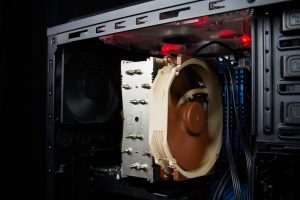 This article has been created in order to help you remove the CPU miner virus, using the fake service.exe process in order to mine for cryptocurrencies on your computer.
This article has been created in order to help you remove the CPU miner virus, using the fake service.exe process in order to mine for cryptocurrencies on your computer.
A new cryptocurrency miner malware, going by the name Service.exe has been detected to roam around and cause infections on computers, all over the globe. The malware has one main purpose and that is to mine for anonymous cryptocurrencies from the likes of BitCoin or Monero. The virus uses the CPU and GPU resources of the infected computer in order to do that and service.exe aims to stay undetected on the computer of the victim for as long time as possible. Since this virus may be directly dangerous to your computer in the long term and may even break some of it’s components, it is recommended that your read the following article in order to learn more about it and remove it from your computer system.

Threat Summary
| Name | service.exe Virus Process |
| Type | Cryptocurrency miner malware. |
| Short Description | Uses your computer’s central processor and video card resources in order to mine for cryptocurrencies and generate income to the hackers who are behind it. |
| Symptoms | Having service.exe process running on your computer may result in it freezing and slowing down in performance. |
| Distribution Method | Via malicious e-mail spam or fake setup wizards. |
| Detection Tool |
See If Your System Has Been Affected by malware
Download
Malware Removal Tool
|
User Experience | Join Our Forum to Discuss service.exe Virus Process. |

Service.exe Miner Virus – Infection
The infection of service.exe miner virus is done via set of tools and activities, which together are executed in a well-calculated system that works without interruption and uses exploits in your Windows operating system in order to cause the infection, while in the same time remaining unnoticed on your computer. Such infection is usually done via an intermediary infection file which may resemble a legitmate:
- Document.
- Setup of a program.
- Key generator.
- Program patch.
- Software activator.
If spread via e-mail the malicious file may be hidden in an archive or linked in third-party file sharing sites, like Dropbox. The malicious e-mails often are well-disguised and can fool even experienced users. Below is one of such e-mails which leads to an infection file:
In addition to via a web link, the malicious file may also be archived and sent as an attachment in one of the following file formats:
→ .docm, .vbs, .wsf, .js, .exe
If you encounter files of this type, it is advisable to not open them and block future e-mails coming from this address.

Service.exe CryptoCurrency Miner Malware – Activity
As soon as infection takes place with this virus, it may immediately drop the service.exe file, which is responsible for mining the designated cryptocurrency and alongside it, other files may also be dropped. The folders in which these malicious files usually reside are:
After this is completed, the malware may also attack the Windows Registry Editor of your computer and add registry entries with data embedded in them that allows the service.exe process to run automatically alongside Windows start-up process. The targeted Windows Registry keys in which this process is done are the Run and RunOnce sub-keys, located in:
→ HKEY_LOCAL_MACHINE\Software\Microsoft\Windows\CurrentVersion\
HKEY_CURRENT_USER\Software\Microsoft\Windows\CurrentVersion\
In addition to those, the service.exe malware may also attack other commonly targeted Windows Registry sub-keys:
→ HKEY_LOCAL_MACHINE\SOFTWARE\Microsoft\Windows\CurrentVersion\Authentication\LogonUI\Background
HKEY_LOCAL_MACHINE\SOFTWARE\Policies\Microsoft\Windows\Personalization
HKEY_CURRENT_USER\Control Panel\Desktop\ScreenSaveTimeOut
HKEY_CURRENT_USER\Control Panel\Desktop
After these Windows registry sub-keys are attacked, the malware may begin to perform various different activities on your computer, which may include:
- Stealing information, like passwords and logins from it.
- Logging your keystrokes.
- Downloading updates to remain hidden on your PC.
The main purpose of the service.exe virus is different than those activities which it may or may not do. It is to mine for cryprtocurrencies, like BitCoin or Monero by enlisting the infected computer in a network of computers which combine their hashing power to mine for the cryptocurrencies and credit the profits from the mining to the wallet of the vendor running them, in this case the creator of the service.exe miner malware. This is very dangerous for your computer, especially if the process remains for longer time running in the background – it may damage components of your computer and break it, making access to your data logically impossible. This is why, it is recommended to remove the service.exe infection as soon as you detect its symptoms of presence, outlined in the Threat Summary table above.

Remove Service.exe CPU Miner Virus from Your PC
In order to remove this unwanted process and all of it’s related virus files and objects from your computer, you should follow the removal instructions below. They are specifically designed in order to help you perform the removal either manually if you have experience in malware removal or automatically if you lack such experience. Be advised that the most effective and fastest method for removal is the automatic approach, especially if you use an advanced anti-malware software, which will scan and remove everything related to the service.exe virus from your computer plus protect it against future parasite files like this one.
Preparation before removing service.exe Virus Process.
Before starting the actual removal process, we recommend that you do the following preparation steps.
- Make sure you have these instructions always open and in front of your eyes.
- Do a backup of all of your files, even if they could be damaged. You should back up your data with a cloud backup solution and insure your files against any type of loss, even from the most severe threats.
- Be patient as this could take a while.
- Scan for Malware
- Fix Registries
- Remove Virus Files
Step 1: Scan for service.exe Virus Process with SpyHunter Anti-Malware Tool



Step 2: Clean any registries, created by service.exe Virus Process on your computer.
The usually targeted registries of Windows machines are the following:
- HKEY_LOCAL_MACHINE\Software\Microsoft\Windows\CurrentVersion\Run
- HKEY_CURRENT_USER\Software\Microsoft\Windows\CurrentVersion\Run
- HKEY_LOCAL_MACHINE\Software\Microsoft\Windows\CurrentVersion\RunOnce
- HKEY_CURRENT_USER\Software\Microsoft\Windows\CurrentVersion\RunOnce
You can access them by opening the Windows registry editor and deleting any values, created by service.exe Virus Process there. This can happen by following the steps underneath:


 Tip: To find a virus-created value, you can right-click on it and click "Modify" to see which file it is set to run. If this is the virus file location, remove the value.
Tip: To find a virus-created value, you can right-click on it and click "Modify" to see which file it is set to run. If this is the virus file location, remove the value.Step 3: Find virus files created by service.exe Virus Process on your PC.
1.For Windows 8, 8.1 and 10.
For Newer Windows Operating Systems
1: On your keyboard press + R and write explorer.exe in the Run text box and then click on the Ok button.

2: Click on your PC from the quick access bar. This is usually an icon with a monitor and its name is either “My Computer”, “My PC” or “This PC” or whatever you have named it.

3: Navigate to the search box in the top-right of your PC's screen and type “fileextension:” and after which type the file extension. If you are looking for malicious executables, an example may be "fileextension:exe". After doing that, leave a space and type the file name you believe the malware has created. Here is how it may appear if your file has been found:

N.B. We recommend to wait for the green loading bar in the navigation box to fill up in case the PC is looking for the file and hasn't found it yet.
2.For Windows XP, Vista, and 7.
For Older Windows Operating Systems
In older Windows OS's the conventional approach should be the effective one:
1: Click on the Start Menu icon (usually on your bottom-left) and then choose the Search preference.

2: After the search window appears, choose More Advanced Options from the search assistant box. Another way is by clicking on All Files and Folders.

3: After that type the name of the file you are looking for and click on the Search button. This might take some time after which results will appear. If you have found the malicious file, you may copy or open its location by right-clicking on it.
Now you should be able to discover any file on Windows as long as it is on your hard drive and is not concealed via special software.
service.exe Virus Process FAQ
What Does service.exe Virus Process Trojan Do?
The service.exe Virus Process Trojan is a malicious computer program designed to disrupt, damage, or gain unauthorized access to a computer system. It can be used to steal sensitive data, gain control over a system, or launch other malicious activities.
Can Trojans Steal Passwords?
Yes, Trojans, like service.exe Virus Process, can steal passwords. These malicious programs are designed to gain access to a user's computer, spy on victims and steal sensitive information such as banking details and passwords.
Can service.exe Virus Process Trojan Hide Itself?
Yes, it can. A Trojan can use various techniques to mask itself, including rootkits, encryption, and obfuscation, to hide from security scanners and evade detection.
Can a Trojan be Removed by Factory Reset?
Yes, a Trojan can be removed by factory resetting your device. This is because it will restore the device to its original state, eliminating any malicious software that may have been installed. Bear in mind that there are more sophisticated Trojans that leave backdoors and reinfect even after a factory reset.
Can service.exe Virus Process Trojan Infect WiFi?
Yes, it is possible for a Trojan to infect WiFi networks. When a user connects to the infected network, the Trojan can spread to other connected devices and can access sensitive information on the network.
Can Trojans Be Deleted?
Yes, Trojans can be deleted. This is typically done by running a powerful anti-virus or anti-malware program that is designed to detect and remove malicious files. In some cases, manual deletion of the Trojan may also be necessary.
Can Trojans Steal Files?
Yes, Trojans can steal files if they are installed on a computer. This is done by allowing the malware author or user to gain access to the computer and then steal the files stored on it.
Which Anti-Malware Can Remove Trojans?
Anti-malware programs such as SpyHunter are capable of scanning for and removing Trojans from your computer. It is important to keep your anti-malware up to date and regularly scan your system for any malicious software.
Can Trojans Infect USB?
Yes, Trojans can infect USB devices. USB Trojans typically spread through malicious files downloaded from the internet or shared via email, allowing the hacker to gain access to a user's confidential data.
About the service.exe Virus Process Research
The content we publish on SensorsTechForum.com, this service.exe Virus Process how-to removal guide included, is the outcome of extensive research, hard work and our team’s devotion to help you remove the specific trojan problem.
How did we conduct the research on service.exe Virus Process?
Please note that our research is based on an independent investigation. We are in contact with independent security researchers, thanks to which we receive daily updates on the latest malware definitions, including the various types of trojans (backdoor, downloader, infostealer, ransom, etc.)
Furthermore, the research behind the service.exe Virus Process threat is backed with VirusTotal.
To better understand the threat posed by trojans, please refer to the following articles which provide knowledgeable details.




